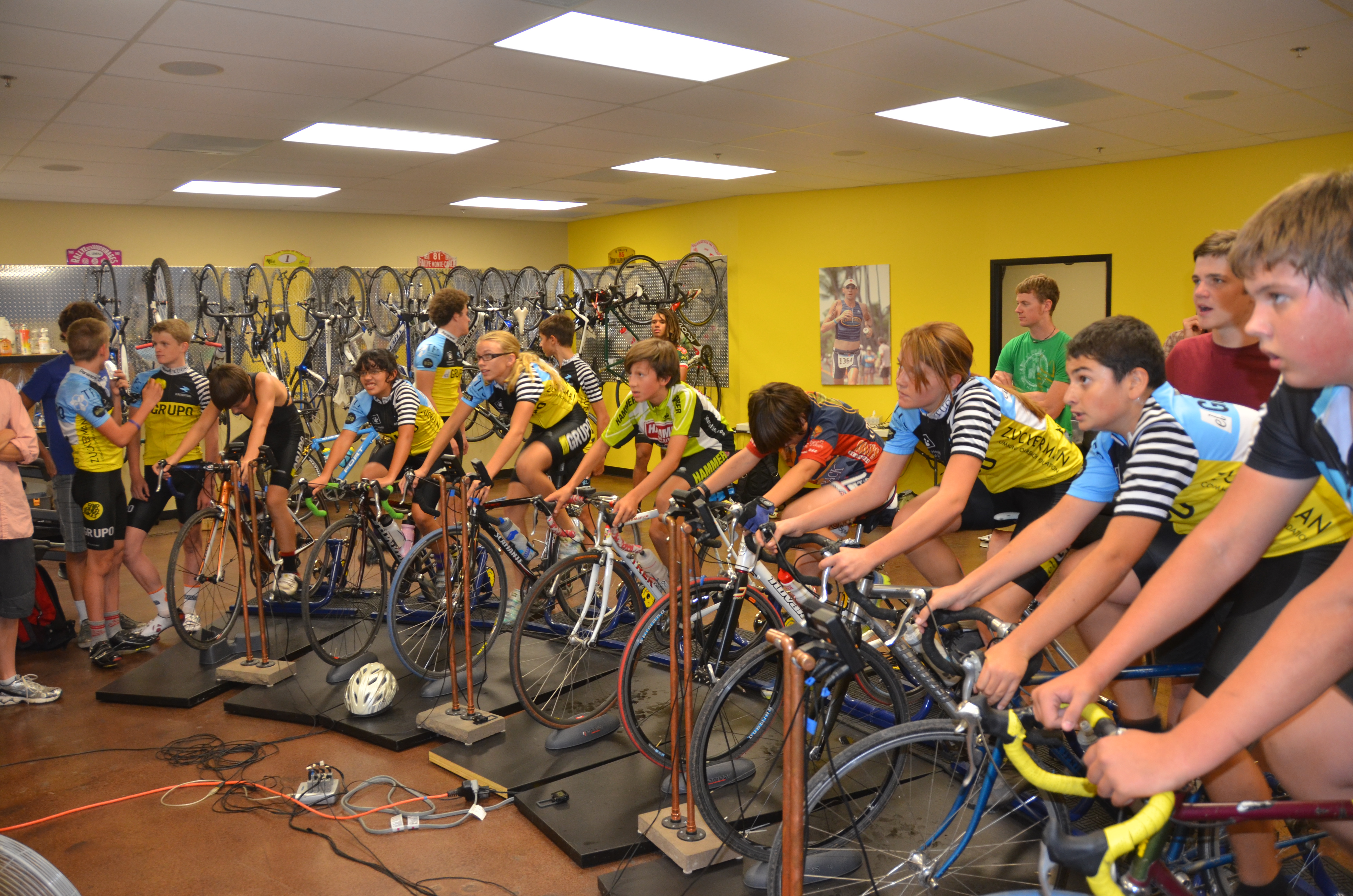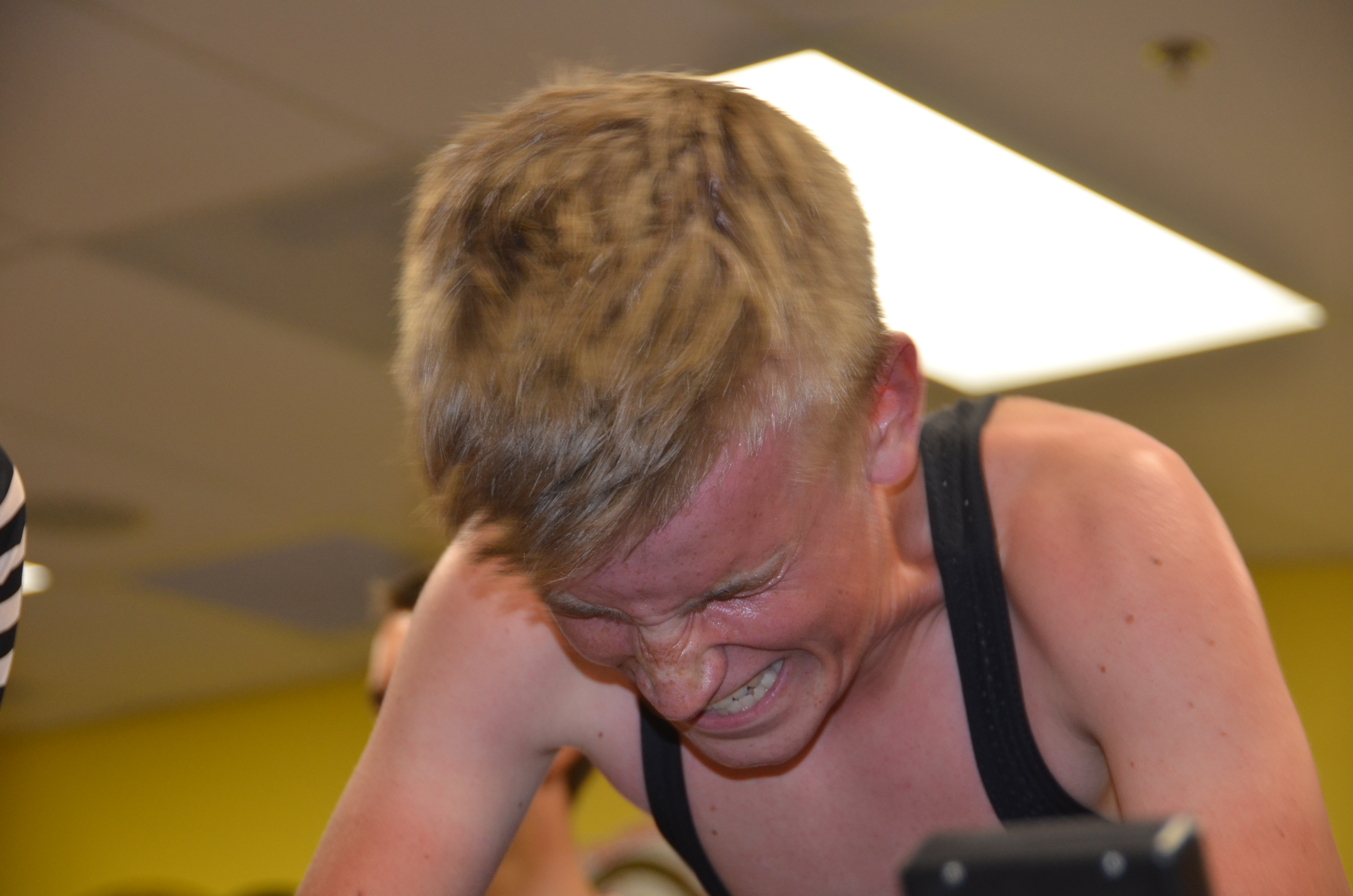El grupo had one of the most important practices of the year Wednesday night. It included an effort of only 9-10 minutes on a trainer at Carmichael Training Systems (CTS). The entire workout consisted of riding a three mile computer course in order to establish training parameters for the year.

Based on the results from the test the kids are able to figure out what their heart rate and Rate of Perceived Exertion (RPE) should be for different workouts. CTS breaks the different zones into Foundation Miles, Endurance miles, Tempo, Steady State Intervals, and Recovery miles. If you are so inclined to know what each of these is, I’ve copied the summary of them at the bottom of this post.
CTS offers a state of the art facility that has 8 trainers hooked up to computers that allows for group races. 23 kids showed up to determine their base line fitness . The A team had a little more challenging course that offered more uphill, while the others had one climb and a majority of the TT like race was downhill. For what seems like an easy 10 minute effort I have not seen as much anguish and outright pain in these kids. The computer not only tracks your watts and speed, but a huge monitor shows exactly where you are in the race compared with the other racers and how many feet you are behind the racer in front of you. For this test, they turned off the “drafting” feature, but it’s possible to set up a life like drafting feature.

Kyle Helmke giving it everything and more.
Head Coach, Jason Tullous, broke down all the info that was gathered to show the kids what their zones are. I’d like to give a special Thanks to all of the CTS staff who stayed very late to get this done. Having industry leading coaching available for El Grupo and all of us who live in Tucson is one of the reasons that Tucson is such an incredible cycling community. Most teams would need to travel many a mile to find what is generously given to EL Grupo. Again, THANKS!
Endurance miles: This is one of the primary workouts for building an aerobic energy system that will increase your endurance capabilities. Expected benefits include: Increased size and strength in slow-twitch muscle fibers. Increased stroke volume from your heart. How to do it: Although similar to the Foundation Miles workout, the pace during the EM workout is quicker than during the Foundation Miles (FM) workout. It is performed at a moderate pace, but at a slightly higher heart rate (or power output) than the FM workout. Use your gearing as you hit the hills to remain in the saddle as you climb. Expect to keep your pedal speed up into the 85-95 RPM range. As with the FM workout, you will have a certain heart rate (or power) range for this workout. The goal is to not exceed the prescribed heart rate (or power) range. Even though the intensity is greater the closer you get to the heart rate ceiling, you are still using aerobic energy to power your cycling. At end of your EM ride, you should have spent at least 95% of the ride below your heart rate ceiling. If you are training with power, the longer the EM is, the lower your average power output should be and vice versa. The appropriate intensity will be determined by the results of the CTS field test. If you are training primarily with heart rate, you don’t need to stay near the top of your EM heart rate range all the time. The range is wide to accommodate the changes in effort level resulting from uphills, downhills, headwinds, tailwinds, stop signs and stoplights.
Steady State Intervals “Goal: Increase your lactate threshold by training at the edge of your aerobic/anaerobic threshold.
Tempo: Strategically placing tempo workouts into your training program has many advantages: Greater comfort while cruising on rolling terrain. Better fuel utilization during long races or rides. Increased capacity for more intense workouts. Better power at moderate intensities. Increased muscle glycogen storage capacity. Improved free fatty acid oxidation, which spares muscle glycogen. Increased mitochondrial development, structures within the muscle cells that produce energy. Improved aerobic efficiency. How to Do It: Pedal speed should be low. Try a 70-75 RPM range while staying at the prescribed heart rate intensity. This helps increase pedal resistance and strengthens leg muscles. Also try to stay in the saddle when you hit hills during your tempo workouts. This adds more pedal resistance and readies the connective tissues and supporting muscle groups before training heads into more explosive workouts. It is important that you try to ride the entire length of the tempo workout with as few interruptions as possible – tempo workouts should consist of consecutive riding at the prescribed intensity to achieve maximum benefit. This intensity will be determined by the results of the CTS field test.
Recovery miles goal is to speed the recovery process by riding at an easy pace at low resistance on flat terrain. Benefits include increasing blood flow to the muscles to help remove muscle soreness, reducing free radical build-up that cause muscle stress and damage. Studies have shown that active recovery at an appropriate pace leads to faster recovery than complete rest. How to do it: Recovery rides should be between 30-120 minutes in length on flat to rolling terrain. Keep your pedal speed slower than normal, staying in a light gear to keep resistance low. Heart rate must also remain low even if you hit any hills, just slow down and use your gears to keep the resistance low. The key to recovery rides is to ride just enough to engage the active recovery process but not long or intense enough to induce a training stress upon yourself. This is a workout that you will use during all your training periods. Even though the temptation is there to vegetate on the couch the day following a tough workout, use RR as an active recovery workout to jumpstart the process of repair and regeneration.